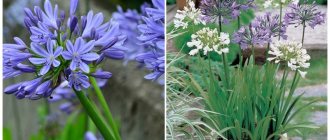The herbaceous perennial plant Eremurus, also called Shrysh, or Shiryash, is a representative of the Asphodelaceae subfamily of the Xanthorrhoeaceae family. This genus includes more than 40 species, hybrids and varieties. The name of this flower is derived from two Greek words, which translated mean “desert” and “tail.” Looking at the dense, tall flower stalks, you can immediately understand why people who lived in ancient civilization named such a plant Eremurus. Among people living in Central Asia, the words shrysh and shiryash mean glue, the fact is that in these places technical glue is obtained from the roots of such a flower. A plaster is made from dried and powdered roots. If the roots are boiled, they can be eaten, and their taste is similar to asparagus, and the leaf blades of some (not all!) types are also eaten. Any part of such a plant can be used to dye natural fiber yellow. Eremurus was first described in 1773 by the Russian traveler, geographer and naturalist P. Pallas. These flowers began to be grown in the botanical gardens of Western Europe and Russia already in the sixties of the 19th century; more than half a century later, the first hybrid was born, while breeders do not stop working with Eremurus to this day.
Description of the plant
Eremurus (Shiryash) (lat. Eremurus) officially belongs to the Asphodelaceae family, native to Central Asia, where it grows in the territory between the Tien Shan mountains, the Pamir range and the Himalayas.
Today, the genus Eremurus includes about 60 species of deciduous perennials, which have spread throughout Russia (even Siberia), Eastern Europe, Turkey, and Ukraine. However, the vast majority of species are still found in Afghanistan, Kazakhstan, Kyrgyzstan, Tajikistan, Uzbekistan, in deserts, semi-deserts, dunes, and steppes. The plant is adapted to the continental climate - harsh winters and dry, hot summers.
The Latin name comes from two Greek words:
- eremia – steppe, desert;
- oura – tail.
These plants are known in the world under different names, and each of them is surprisingly accurate - shiryash, steppe lily, fox tail, fox lily, desert candle, king's spear, Cleopatra's candle - all these options well reflect the unusual shape of the perennial.
In the wild, Eremurus are a truly amazing sight. They grow in vast clusters, untouched by any herbivores, delighting with tall, curling upward, arched inflorescences resembling the shape of candles or a foxtail lily.
Plant characteristics:
- The stems are long, accompanied by a mundane rosette of narrow leaves. Many species, with the exception of Robustus, reach a height of 2 m, although in garden conditions they more often reach 100-150 centimeters. The species E. robustus reaches 3 m. Half the length of the shoot is occupied by the inflorescence in the form of an elongated floating cluster.
- The leaves are narrow, herbaceous, form a wide tuft, and grow quite quickly, soon after the flower shoot appears. After Eremurus blooms, the leaves die off and the plants go into a state of summer dormancy.
- Flowers with intense colors: yellow, white, orange, pink, even brown. The inflorescences are long, consisting of many tiny, brightly colored, star-shaped flowers with long, prominent anthers. The size of the inflorescence is 50-60 cm, as it develops from the bottom up, it resembles a slightly pointed tower or a fluffy fox tail. The flowering period of Eremurus can last a month; all species bloom, depending on the weather, in late May - early June.
- Roots. The underground part consists of rather unusual, branching rhizomes, reminiscent of woody starfish. They grow horizontally in all directions, creating the effect of charming circular clusters.
Thanks to their beautiful appearance and originality, Eremuruses found their way into international culture, and ambitious gardeners not only used beautiful natural species, but were also tempted to grow attractive hybrids. At our garden market you can already easily purchase popular varieties that bloom during several weeks of June or July.
Features of Eremurus
Eremurus has a root that is similar in appearance to a starfish. The diameter of the Cornedonian varies from 10 to 15 centimeters, and its shape is disc-shaped; twisted fleshy roots extend from it, cylindrical or spindle-shaped, thickened, and they stick out in different directions. The bush most often contains a large number of flat triangular-linear leaf plates, which can be narrow or wide, their lower surface is keeled. A large elongated racemose inflorescence, meter long, is located on a single leafless shoot. Bell-shaped flowers on the peduncle are arranged in a spiral, and they can be colored yellow, brown, dusty red or pink. The flowers begin to open from the bottom of the inflorescence, with each flower fading approximately 24 hours after blooming. The duration of flowering directly depends on the type and variety of the plant and can vary from 10 to 40 days. The fruit is a three-locular semi-lignified or membranous capsule of almost spherical shape, which cracks when ripe; its surface can be wrinkled or smooth. Triangular wrinkled seeds have 1 transparent wing. This flower is a very good honey plant.
EREMURUS - CULTIVATION, CARE AND DISEASES
What types and varieties to choose?
The most famous eremurus include:
- Eremurus powerful (E. robustus) is the tallest species, reaching up to 150-300 cm in garden conditions. It is distinguished by white or pale pink flowers. Inflorescences (60 cm) on long stalks appear in May. The species is not completely frost-resistant, so it should be covered with a layer of leaves before winter. The leaves begin to grow early, so they are subject to freezing and should be protected from spring frosts.
- The Himalayan Eremurus (E. himalaicus) is a popular choice for gardeners to grow and is especially elegant in its snow-white color.
- Narrow-leaved Eremurus (E. stenophyllus) is the third popular species; it is lower (up to 1 m) and is distinguished by exceptionally abundant and colorful flowers.
- The latest, in July-August, Eremurus Olga (E. olgae) blooms. Peduncles grow up to 2 meters, the flowers are pink with a burgundy stripe.
Among professional breeders, 2 noble varieties of Eremurus Isabella (E. x isabellinus) are highly valued:
- “Cleopatra” Cleopatra – exotic dark orange;
- “Pinokkio” Pinokkio – yellow-orange.
Elegant hybrids are also prized:
- white “White Beauty” White Beauty;
- salmon “Romance” Romance.
These are plants that will easily change the appearance of any flower bed and will delight you for many years!
Landing
The unusual appearance and exceptionally intensive growth are not the only advantages of the plant. Under natural conditions, this flowering giant grows in mountain, steppe and desert areas. As a result, it is very resistant to lack of moisture and grows well on light, sandy, infertile substrates. In order for eremurus to grow well and delight with beautiful inflorescences, you need to choose the right place for them in the garden and plant them correctly.
How to choose good seedlings?
The correct choice of variety does not guarantee spectacular flowering if you do not take care of the good condition of the seedlings. Before purchasing, make sure that the roots are not moldy or broken. They must be healthy. The rhizomes have a characteristic shape - they resemble a small octopus. In fact, it is a thickened part of the shoot from which fragile branches extend radially.
High-quality rhizomes are clean, without dark spots, fungal deposits, branched, hard and fleshy, with branches spreading horizontally to the sides.
You need to buy rhizomes in late summer and autumn. They can be found in garden stores and online stores. Shopping at a garden center has an advantage: you can look at each specimen and choose the largest and most beautiful ones yourself. However, it is in online stores that we will find the widest selection of new interesting color varieties.
After purchasing, rhizomes should be planted as soon as possible; they do not tolerate storage well. When purchasing in the spring (storing in the refrigerator), it is better to soak the planting material for 2-3 hours and plant immediately.
Soil requirements
Eremurus is a rather demanding perennial that can be called capricious. On the one hand, it prefers dry, even desert places; on the other hand, it requires a significant amount of water during the flowering period. Thus, the ideal soil for Eremurus should be:
- perfectly drained;
- quite fertile;
- with a tendency to dry out during cold periods;
- reaction from slightly acidic to alkaline (pH 6-8).
You need to choose a planting site for Eremurus:
- warm;
- sunny;
- protected from cold wind;
- unshaded;
- protected from stagnant water.
If the soil in the garden is heavy and loamy, Eremurus are planted in raised beds with good drainage.
Landing
The best time to plant Eremurus in open ground is autumn, warm, sunny September. Whole seedlings are not planted, but only healthy, dormant rhizomes.
Planted in September before winter, they have time to take root and winter better.
The rhizomes are very fragile and require special care when placed in the ground and therefore require wide planting holes. Plant them deep enough so that the plants do not tip over under the weight of the inflorescences.
A hole is dug with dimensions:
- width – 40 centimeters;
- depth – 8-15 cm.
The optimal planting depth for Eremurus is 3 times the height of the rhizome.
Distance between plants: at least 50-90 cm.
The colder the climate, the deeper underground the roots should be located. In the Moscow region, Eremurus is planted to a depth of 10 cm, the root itself is sprinkled with a layer of soil of about 2-3 cm.
Planting Eremurus rhizomes:
- Before planting, the place under the eremurus should be dug up, loosened, enriched with humus, for example compost (a 10-liter bucket of compost per 1 square meter of soil is added). In the locking areas it is better to add a small mound.
- We dig holes. You should add 1-2 handfuls of good soil, preferably compost, to the bottom.
Attention! If the soil is clay, good drainage is necessary. To do this, we dig a fairly large hole (40 cm deep), pour 10-20 cm of crushed stone (gravel, pebbles) onto the bottom, then 10 cm of sand, then 10 cm of soil mixed with a large amount of sand. This will ensure a good outflow of water, the plant is afraid of stagnation.
- We place each rhizome in a separate hole, maintaining the appropriate distance between individual plants. The root is placed horizontally in the hole. Ideally, not a single root should be bent. During September-October, the main roots will sprout small roots, the plant will take root before winter. When planting, it is important to position the rhizome correctly, with the bud up (see photo). We fill the hole with soil mixed with sand.
- It is good to mark the planting sites with a peg so that during subsequent gardening work you do not accidentally damage the rhizomes.
- On top it is worth pouring an additional layer of mulch (compost) 10 cm high and 24-40 cm wide, which will provide the substrate with nutrients and protect it from the cold of the first winter.
Growing Eremurus from seeds
Sowing
Seeds are sown in open soil at the beginning of spring. When the seedlings appear, it will be necessary to plant them, and a distance of 0.3 to 0.6 m should be maintained between the bushes. However, experienced gardeners recommend growing Eremurus through seedlings.
Seedling
Sowing seeds for seedlings should be done in September–October. A container for seedlings should be chosen that is at least 12 centimeters deep. The seeds should be buried 10–15 mm, and the germination container should be placed in a cool (about 15 degrees) place. At the beginning of spring, seedlings should appear, but not all seeds can sprout, and this is because some of them can take up to two years to germinate. Seedlings should be watered more often than adult plants; after the leaf blades wither, a dormant period will begin, and at this time it is recommended to move the eremurus to a dark room. When September or October comes, the plants will need to be transplanted into individual pots, which are taken outside. After frosts begin, the removed seedlings will need to be covered with compost, leaves or spruce branches, keeping in mind that the layer should be no thinner than 20 centimeters. The shelter is removed in the spring, when it is warm enough outside. In this way, seedlings are grown for 3 years. After this, the Cornedons should be planted in open soil. After their above-ground part grows, the bushes will need to be cared for in the same way as adult specimens.
Growing and care
Eremurus requires almost no maintenance. In the spring, when the roots begin to sprout, you need to carefully loosen the soil around it with a stick, without using a hoe.
Trimming
In Eremurus, it is not necessary to remove faded inflorescences - some gardeners like dried flower stalks proudly rising in the flowerbed, as a symbol of the end of the first phase of summer. However, there are no contraindications to their gradual removal.
When removing foliage, you should wait until it becomes completely yellow and dry - before that it still feeds the rhizome.
Supports
In some cases, tall Eremurus flowers may need support if there are strong winds in the area. To do this, you should choose thin poles and drive them in very carefully so as not to damage the underground rhizomes.
Watering
As soon as shoots and leaves begin to develop from the rhizome, Eremurus needs watering. The plant becomes greedy when it comes to water. Water frequently during periods of drought and heat, especially if the soil seems dry.
However, when the flowers begin to bloom, the plants enter a period of summer dormancy and hydration should be limited as much as possible. Thanks to the fleshy, thick rhizomes and extensive roots, the plants cope well with prolonged lack of water; during the dormant period they do not need watering at all.
Fertilizers and fertilizers
Eremurus are very demanding regarding adequate supply of nutrients. Fertilizers play an important role in caring for Eremurus. Multicomponent fertilizers should be applied once a month from late spring until the end of the flowering period. Sprinkling bone meal or ash on the flower bed also gives good results.
Care in autumn, wintering
In the climate of the Moscow region and Central Russia, Eremurus overwinters well. It is winter-hardy and does not require digging or special protection. However, frosts of the order of -30 degrees C can damage the rhizomes, so in very harsh winters it is worth covering the eremurus with a thick layer of organic substrate - leaves, sawdust, twigs. This additional shelter must be protected from the wind.
In the climate of the Moscow region, summer residents recommend mulching Eremurus with a layer of 20 cm for the winter.
In spring, the cover is removed quite early, since the germinating shoots are quite fragile and can be easily damaged. To protect against night frosts, use paper caps or plastic bottles with the bottom cut off.
Some gardeners dig up Eremurus for the winter, like tulips, and store them in a dry place. This is especially true in areas with soaking clay soil, in cold regions.
Diseases and pests
Eremurus rarely becomes a victim of pests; its only natural enemies are snails. In the spring, when the plant produces its first shoots, it is worth carefully protecting it from slugs and snails, which can greatly spoil the appearance for the whole season.
To prevent possible fungal diseases, periodic use of copper-based fungicides can be recommended. Summer residents practice preventive spraying with fungicides in rainy years.
Why doesn't Eremurus bloom?
Problems of poor growth or lack of flowering are primarily due to improper growing conditions:
- shadow;
- cool;
- excessive soil moisture.
Transfer
After 3-4 years, all rhizomes should be dug up and sorted. Then you need to mix the planting site with compost soil and replant the largest specimens. It is better to plant small tubers in a separate group; they will not bloom until next year.
Eremurus after flowering
Collecting seeds
Good seeds can only be collected from the lower part of the candle inflorescence. In this regard, it is recommended to select 2 inflorescences and shorten them at the top by 1/3. During ripening, the fruits turn beige. Seed collection should begin in the second half of August. The inflorescence cut with pruning shears should be placed for ripening in a well-ventilated and dry room. In the last days of October, well-dried boxes should be rubbed with your hands over a sheet of newspaper, onto which the seeds will be poured. They are blown and sown.
Wintering
As a rule, Eremurus has high frost resistance. However, there are also heat-loving species that need shelter for the winter; for this, the area is covered with a layer of peat or compost (at least 10 centimeters thick). Cornedons that were dug up in the summer cannot be stored all winter, because as soon as spring comes, they begin to actively grow even without being planted. Planting in open soil should be carried out in the autumn, and the plantings must be covered with a layer of peat. At the same time, for regions with frosty winters with little snow, you will need to lay spruce branches on top. The shelter must be removed in the spring, when the threat of frost has passed. If frost is still expected, then the area will need to be temporarily covered with a covering material, for example, lutrasil.
Reproduction
By division
Eremurus does not like digging and maneuvers associated with moving soil around the rhizomes. A mature large plant can and even should be divided every few years. This way we will get new seedlings for the garden and rejuvenate the flower a little.
Eremurus division is best done at the end of summer, after flowering, when the leaves wither. You need to carefully dig up the entire plant, separate the overgrown sections, and use a disinfected pruner to cut off some branches of the rhizome. All planting material obtained in this way is immediately planted in the soil.
Seeds
Eremurus is also propagated from seeds obtained from spherical boxes formed at the tops of flower stalks. But propagating Eremurus by seeds is a very tedious process - we will wait for the first flowering only after 4-5 years. Only fresh autumn seeds are sown. Seedlings are grown in pots at home for the first 2-3 years, watered abundantly in spring and summer and to a lesser extent in autumn and winter.
Diseases and pests
Possible diseases:
Rust (in damp, warm weather, the leaves become covered with brown spots and black streaks). Remove affected areas, treat with fungicide;
Fungal infections (the surface of the leaf blade becomes tuberous, yellow spots appear). Affected plants should be removed and burned;
Chlorosis (leaves become pale, yellowish). Most likely the roots of the plant are dying. It is necessary to dig up the bush, trim the affected areas, treat the cut areas with a fungicide and return the plant to the soil.
Pests:
- thrips, aphids (settle on leaves, it is necessary to treat with an insecticide);
- slugs (collect by hand, use traps);
- the roots can be eaten by field mice and moles (roots affected by pests begin to rot - the actions are the same as when affected by chlorosis. Use traps against pests).
Application in the garden
The extraordinary beauty and splendor of Eremurus make them an ideal candidate for decorating flower beds, especially those located in full sun. The strong stems courageously withstand strong winds, and the plants are resistant to prolonged exposure to the sun. All this makes them an ideal option for sunny gardens located on less fertile and dry soils.
It is not recommended to create compositions consisting only of eremurus, since they have a relatively short flowering period, after which the shoots and leaves are unattractive. Therefore, landscape designers usually combine species of the genus Eremurus with taller perennials that bloom until late summer, for example:
- lavender;
- rudbeckia;
- eryngium;
- helenium;
- roses.
When planning, you need to be careful - eremurus do not tolerate too close proximity to other plants with a developed root system. According to some sources, bulbous flowers will cause the least harm to it:
- lilies;
- gladioli;
- decorative garlic;
- irises.
The leaves of the plant begin to dry out already during the flowering period. Therefore, it should be planted at the back of the flower bed. A tall inflorescence will please the eye, and other plants will cover the drying leaves, and after the leaves dry, there will be an empty space.
The Eremurus flower is extremely impressive when cut, can be combined into colorful bouquets, and lasts a long time in a vase.
Planting Eremurus seedlings in open ground
When and where to plant
Erimus is planted in open ground in September. Choose an open, sunny area. Strong stems are not afraid even of strong winds.
Priming
The plant is not picky about the composition of the soil. It should be well drained, neutral or slightly alkaline. It has been noted that on fertile soils flowering occurs later.
How to plant
Dig a wide hole about 25-30 cm deep, add a layer of coarse sand 5 cm thick, roll over the spider-shaped rhizome along with a lump of earth, then add soil (turf soil, humus, compost). The rhizome should be underground at a depth of 5-7 cm. Keep a distance of 25-30 cm between low-growing species, 40-50 cm between tall species, and 70 cm between rows. Water well after planting.
Related article: Popular varieties of tulips, groups and classes of flowers











